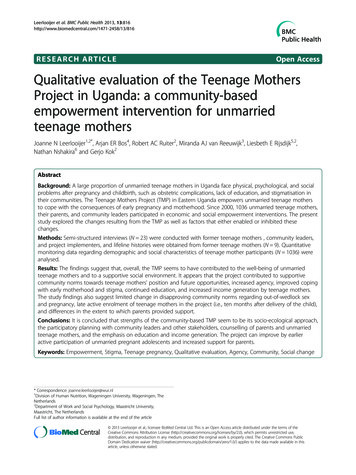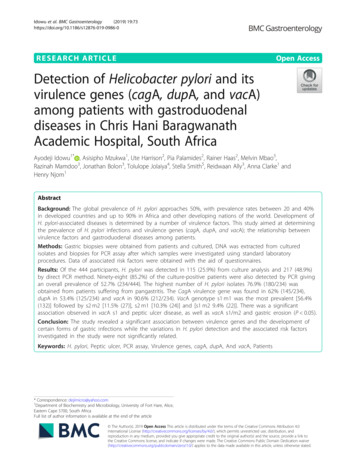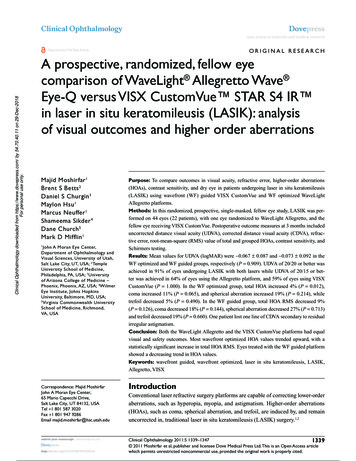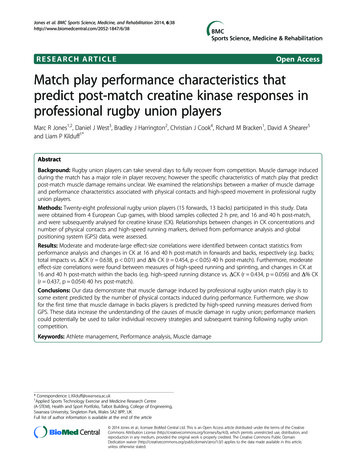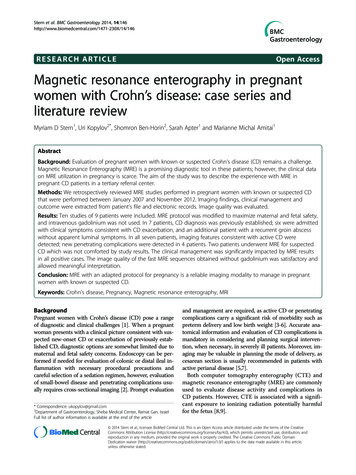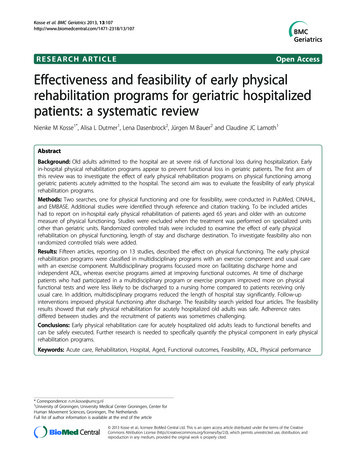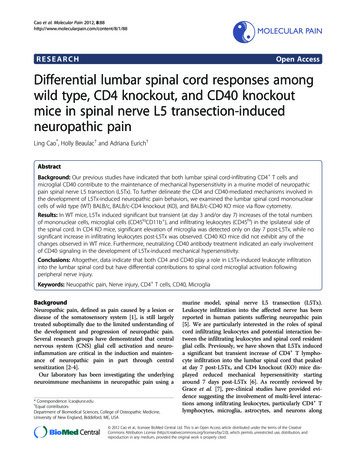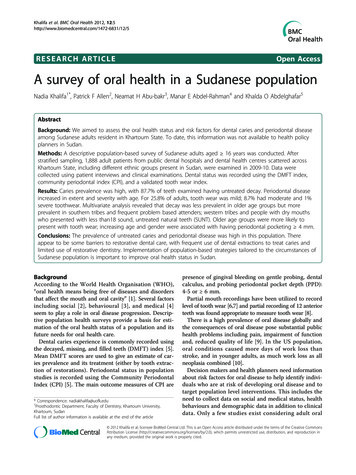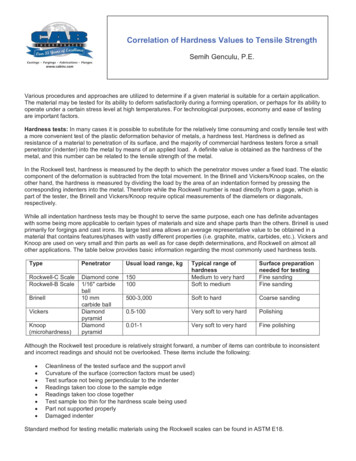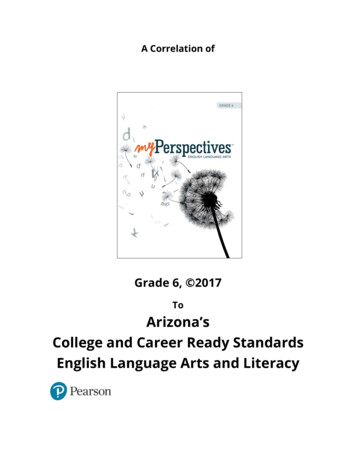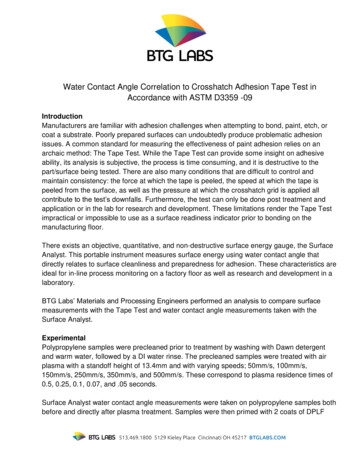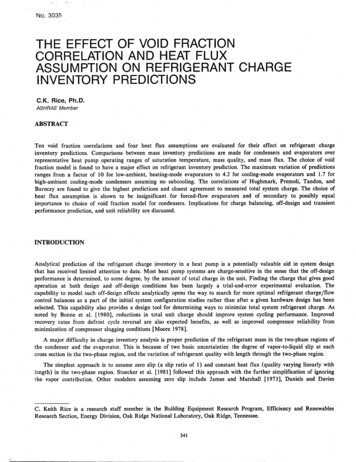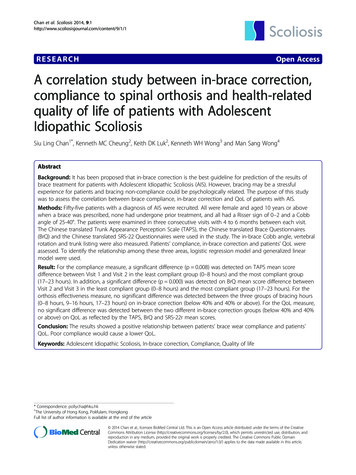
Transcription
Chan et al. Scoliosis 2014, SEARCHOpen AccessA correlation study between in-brace correction,compliance to spinal orthosis and health-relatedquality of life of patients with AdolescentIdiopathic ScoliosisSiu Ling Chan1*, Kenneth MC Cheung2, Keith DK Luk2, Kenneth WH Wong3 and Man Sang Wong4AbstractBackground: It has been proposed that in-brace correction is the best guideline for prediction of the results ofbrace treatment for patients with Adolescent Idiopathic Scoliosis (AIS). However, bracing may be a stressfulexperience for patients and bracing non-compliance could be psychologically related. The purpose of this studywas to assess the correlation between brace compliance, in-brace correction and QoL of patients with AIS.Methods: Fifty-five patients with a diagnosis of AIS were recruited. All were female and aged 10 years or abovewhen a brace was prescribed, none had undergone prior treatment, and all had a Risser sign of 0–2 and a Cobbangle of 25-40 . The patients were examined in three consecutive visits with 4 to 6 months between each visit.The Chinese translated Trunk Appearance Perception Scale (TAPS), the Chinese translated Brace Questionnaires(BrQ) and the Chinese translated SRS-22 Questionnaires were used in the study. The in-brace Cobb angle, vertebralrotation and trunk listing were also measured. Patients’ compliance, in-brace correction and patients’ QoL wereassessed. To identify the relationship among these three areas, logistic regression model and generalized linearmodel were used.Result: For the compliance measure, a significant difference (p 0.008) was detected on TAPS mean scoredifference between Visit 1 and Visit 2 in the least compliant group (0–8 hours) and the most compliant group(17–23 hours). In addition, a significant difference (p 0.000) was detected on BrQ mean score difference betweenVisit 2 and Visit 3 in the least compliant group (0–8 hours) and the most compliant group (17–23 hours). For theorthosis effectiveness measure, no significant difference was detected between the three groups of bracing hours(0–8 hours, 9–16 hours, 17–23 hours) on in-brace correction (below 40% and 40% or above). For the QoL measure,no significant difference was detected between the two different in-brace correction groups (below 40% and 40%or above) on QoL as reflected by the TAPS, BrQ and SRS-22r mean scores.Conclusion: The results showed a positive relationship between patients’ brace wear compliance and patients’QoL. Poor compliance would cause a lower QoL.Keywords: Adolescent Idiopathic Scoliosis, In-brace correction, Compliance, Quality of life* Correspondence: pollycha@hku.hk1The University of Hong Kong, Pokfulam, HongkongFull list of author information is available at the end of the article 2014 Chan et al.; licensee BioMed Central Ltd. This is an Open Access article distributed under the terms of the CreativeCommons Attribution License (http://creativecommons.org/licenses/by/2.0), which permits unrestricted use, distribution, andreproduction in any medium, provided the original work is properly credited. The Creative Commons Public DomainDedication waiver ) applies to the data made available in this article,unless otherwise stated.
Chan et al. Scoliosis 2014, ckgroundIt had been documented that some researchers believethat orthotic treatment does not alter the natural historyof AIS, whereas others believe it can help stop somecurves from progressing [1]. From the landmark randomized multicenter study of Weinstein et al. [2], however, itconfirmed that the orthotic treatment can help to decreasethe progression of curve to the threshold for surgery.Nonetheless, researchers have shown that the best guideline for predicting the results of brace treatment is the response of the spinal curve to the brace, especially duringthe first year of treatment. Thus, to truly reflect the effectiveness of orthotic treatment, in-brace correction shouldbe evaluated in this respect. More importantly, patients’compliance with orthotic treatment, i.e., brace wear compliance, should not be ignored because corrective bracingyields a favourable outcome when the patient is compliant[3]. Weiss [4], in fact, reported that a direct relationshipexists between outcome and patient's compliance withorthotic treatment. Weinstein et al. [2] also detected that asignificant association was found between the averagehours of daily brace wear and the likelihood of a successfuloutcome. Landauer et al. [3] highlighted the importance ofcompliance: patients with good initial correction can expect a final outcome of around 7 improvement in theCobb angle. However, bracing may be a stressful and traumatic experience, and compliance with an orthotic treatment protocol likely depends upon the patient’s physical,emotional and social well-being. Rivett et al. [5] stated thatAIS may itself precipitate social problems for the patients,with orthotic treatment further affecting self- and bodyimage, interactions with others and overall quality of life.Lack of compliance to orthotic treatment could have apsychological element.As reflected by the previous studies, there seem to be relationships between the effectiveness of orthosis, patients’compliance and patients’ QoL. Scientifically, a more reliable and representative outcome measure can be expectedby assessing patients’ compliance on both a subjective andan objective bases. The relationship between patients’ compliance and orthosis effectiveness could be correlated, aswell as the orthosis-wear behaviour as shown by the QoLmeasure. Therefore, there is a need to explore the correlation between the effectiveness of orthosis, patients’ compliance with spinal orthosis as assessed by subjective andobjective measures and their effect on patients’ QoL. Thepurpose of this study was to assess the correlation betweenthe effectiveness of orthosis in terms of in-brace correction, compliance with spinal orthosis and the HRQoL ofpatients with AIS during the initial treatment period.MethodsThis was a prospective correlational study that exploredthe relationships between the effectiveness of orthosisPage 2 of 12(in-brace correction), compliance with orthosis and theHRQoL of the patients with AIS. SRS inclusion criteriaas set by the SRS committee were adopted. Fifty five patients were recruited from the Department of Prostheticsand Orthotics at one of the local hospitals in HongKong. All had a diagnosis of AIS, all were female aged10 years or above when the brace was prescribed, andnone had undergone prior treatment. All had a Rissersign of 0 to 2 and a Cobb angle that measured between25 and 40 . Approval for the study was obtained fromthe IRB of HKU/HA HKW.Three areas – the effectiveness of orthosis, patients’compliance and patients’ QoL – were assessed. The effectiveness of orthosis refers to the physical changes thatresult from orthotic treatment, and the focus was on inbrace correction. A TLSO (underarm brace), named theHong Kong brace, was used for scoliotic curves at thethoracic region (with curve apex below T8) and/or lumbar region. Orthotists followed the standard proceduresof casting, rectification, fabrication and fitting of thetailor-made orthosis. They adopted the three-point pressure system in making the HK brace. The brace-treatedsubjects were instructed to apply the correct pressure bypulling the straps of the brace to the marks on the strapsthat were designated by the orthotists. Clinical parameters such as Cobb angle, vertebral rotation and trunklisting were measured prospectively. Compliance refersto patient's compliance with spinal orthosis. The subjects were asked to log the time spent wearing the braceeach day on the Log Sheet for Wearing Orthosis. Instruction was given to subjects and their parents on howto log the brace wearing time. In addition, they wereinstructed to use the remark column of the Log Sheetto log the non brace wearing time. These self-reporteddata were reviewed daily by the parents and at everyfollow-up visit by the author. Apart from the subjective logsheet data, objective data were obtained from an orthosismonitoring system that was installed on patient’s brace.The system was used for checking patient’s compliance.Brace wearing time was recorded via a force sensor. Dueto the limited supply of the orthosis monitoring systems,the tracking period for the subjects ranged only from2 to 4 months. QoL refers to the psychosocial aspectsof orthotic treatment. QoL instruments including theChinese version of the SRS-22 outcome instrument, theChinese version of Trunk Appearance Perception Scaleand the Chinese version of Brace Questionnaire wereadopted in this study. These questionnaires were chosenbecause of their user-friendliness, satisfactory internalconsistency, reproducibility and responsiveness to changein QoL of patients with AIS treated with bracing [6,7].Regarding the subjects, they returned to the clinicevery 4 to 6 months for follow-up after their initialvisit. Two consecutive follow-up examinations were
Chan et al. Scoliosis 2014, rformed. The physical parameters were measured ateach visit. During Visit 1, subjects were asked to fill outthe TAPS questionnaires. During Visits 2 and 3, subjectsneeded to fill out the TAPS, BrQ and SRS-22r questionnaires and to submit the daily log sheets for brace wear.To measure the correlation between orthosis effectiveness,patients’ compliance with brace wear and patients’ QoL,the in-brace correction (Cobb angle), the compliance pattern, TAPS, BrQ and SRS-22r mean scores were analysed.The relevant data from each visit were summarised by descriptive statistics, including mean, standard deviation,minimum and maximum. To identify the relationshipbetween patients’ compliance and in-brace correction, thelogistic regression model was used. To explore the relationship between patients’ compliance and patients’ QoL,the GLM was used. The GLM was also adopted to explainthe relationship between in-brace correction and patients’QoL. By analysis of the data collected by the orthosismonitoring systems, wearing time vs prescribed time wasdetermined and reported as descriptive statistics includingmean, standard deviation, and minimum and maximum.These values were analysed in relation to the subjectivecompliance data (number of wearing hours) as reportedby the subjects.ResultsFifty-five subjects were recruited initially but a total of23.7 per cent dropout was recorded. In the dropout, 6 ofthem had withdrawn from the study voluntarily, 5 ofthem had been lost to follow-up (no in-brace radiographwas recorded in the subsequent visits) and 2 of themhad sought for alternative therapy. There were 42 subjects that were included for analysis. Among the subjects, 15 of them were of thoracic major curvatures and27 were of thoracolumbar major curvatures. At inclusion, 22 subjects were in the pre-menarchal stage and 20subjects were in the post-menarchal stage. The meanage was 12.60 years ( 1 SD: 1.01, range: 11–15), themean menarchal status was 3.31 months ( 1 SD: 4.30,range: 0–12 months) and 26 subjects had Risser sign 0,11 had a Risser sign 1 and 5 had a Risser sign 2. Subjectswere followed up in 3 consecutive visits. The physicalparameters such as Cobb angle, vertebral rotation andtrunk listing were measured in each visit. The 95% confidence interval for intraobserver variability of Cobbangle, vertebral rotation and trunk listing measurementwas 2.8 , 2 and 3.2 mm respectively, upon Visit 1, 3.2 ,1.8 and 4.2 mm, respectively, upon Visit 2, and 3.0 , 1.6 and 4.5 mm, respectively, upon Visit 3.During Visit 1, the subjects filled out the TAPS questionnaires before brace fitting. During Visit 2 and Visit3, the subjects filled out the TAPS, BrQ and SRS-22rquestionnaires, submitted the daily log sheets of bracewear and underwent in-brace radiography. The averagePage 3 of 12in-brace Cobb angle correction upon Visit 2 and Visit 3was 10.9 ( 1 SD: 5.6, range: 2.5-26.0 ) and 10.4 ( 1 SD:5.9, range: 0.2-28.9 ) respectively. Moreover, the correctioneffect was higher for the thoracolumbar curve patterns(mean: 12.9 , 1 SD: 5.69, range: 2.5-26.0 ) than for thethoracic curve patterns (mean: 7.5 , 1 SD: 3.45, range:3.3-14.7 ) upon Visit 2. The correction effect was alsohigher for the thoracolumbar curve patterns (mean: 12.9 , 1 SD: 5.2, range: 3.6-28.9 ) than for the thoracic curvepatterns (mean: 5.9 , 1 SD: 4.5, range: 0.2-14.7 ) uponVisit 3. The mean, 1 SD and range of physical parameters, curve patterns, bracing hours as recorded on the logsheets and the respective QoL data for the three visitswere summarised in Table 1.Correlation between brace compliance and in-bracecorrectionOn Visit 2, the in-brace Cobb angle was compared tothat of Visit 1 (pre-brace visit). Subjects were categorisedinto two groups according to in-brace correction: 40%or above (n 13) and below 40% (n 29). In addition,subjects were categorised according to bracing hours asfollows: 0–8 hours (group 1), 9–16 hours (group 2) and17–23 hours (group 3). Upon Visit 2, there were 4 subjects in group 1, 7 subjects in group 2 and 31 subjects ingroup 3. The percentages of in-brace correction (40% orabove and below 40%) were entered into a logistic regression model as dependent variables. In the finalmodel, no significant difference was detected betweenthe three groups of bracing hours on in-brace correction. The in-brace Cobb angle upon Visit 3 was compared to that of Visit 1. Upon Visit 3, there were 18subjects with in-brace correction 40% or above and 24subjects with in-brace correction below 40%. Regardingbracing hours, there were 5 subjects in group 1, 8 subjects in group 2 and 29 subjects in group 3. Accordingto the same model, no significant difference was observed between the three groups on in-brace corr
brace treatment for patients with Adolescent Idiopathic Scoliosis (AIS). However, bracing may be a stressful experience for patients and bracing non-compliance could be psychologically related. The purpose of this study was to assess the correlation between brace compliance, in-brace correction and QoL of patients with AIS. Methods: Fifty-five patients with a diagnosis of AIS were recruited .
